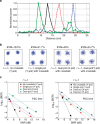High-capacity millimetre-wave communications with orbital angular momentum multiplexing
- PMID: 25224763
- PMCID: PMC4175588
- DOI: 10.1038/ncomms5876
High-capacity millimetre-wave communications with orbital angular momentum multiplexing
Abstract
One property of electromagnetic waves that has been recently explored is the ability to multiplex multiple beams, such that each beam has a unique helical phase front. The amount of phase front 'twisting' indicates the orbital angular momentum state number, and beams with different orbital angular momentum are orthogonal. Such orbital angular momentum based multiplexing can potentially increase the system capacity and spectral efficiency of millimetre-wave wireless communication links with a single aperture pair by transmitting multiple coaxial data streams. Here we demonstrate a 32-Gbit s(-1) millimetre-wave link over 2.5 metres with a spectral efficiency of ~16 bit s(-1) Hz(-1) using four independent orbital-angular momentum beams on each of two polarizations. All eight orbital angular momentum channels are recovered with bit-error rates below 3.8 × 10(-3). In addition, we demonstrate a millimetre-wave orbital angular momentum mode demultiplexer to demultiplex four orbital angular momentum channels with crosstalk less than -12.5 dB and show an 8-Gbit s(-1) link containing two orbital angular momentum beams on each of two polarizations.
Figures





References
-
- Allen L., Beijersbergen M. W., Spreeuw R. J. C. & Woerdman J. P. Orbital angular-momentum of light and the transformation of Laguerre-Gaussian laser modes. Phys. Rev. A 45, 8185–8189 (1992). - PubMed
-
- Gibson G. et al. Free-space information transfer using light beams carrying orbital angular momentum. Opt. Express 12, 5448–5456 (2004). - PubMed
-
- Poynting J. H. The wave motion of a revolving shaft, and a suggestion as to the angular momentum in a beam of circularly polarised light. Proc. R. Soc. Lond. A 82, 560–567 (1909).
-
- Yao A. M. & Padgett M. J. Orbital angular momentum: origins, behavior and applications. Adv. Opt. Photonics 3, 161–204 (2011).
-
- Molina-Terriza G., Torres J. P. & Torner L. Twisted photons. Nat. Phys. 3, 305–310 (2007).
Publication types
LinkOut - more resources
Full Text Sources
Other Literature Sources
Miscellaneous

